Is Living in a House with Mold Dangerous?
While mold is important in nature, it can be a reason for concern in your home. Luckily, most types of mold are generally innocent, but a little spot may later become a big problem. When mold procreates, it releases spores into the air which can cause problems if breathed in by those with mold allergies or respiratory issues. According to a few studies, there is a correlation between an early exposure to mold and the development of asthma in some younger children.
For a majority of people, household mold, mildew or fungi is nontoxic and goes unnoticed. However, it can have an effect on other folks who are sensitive or who have asthma. In most cases, the density of the mold and severity of a person’s allergies has the most effect on their reaction. Sneezing, coughing, runny nose, red eyes, wheezing, headaches and similar cold-like symptoms are most often associated with mold and mildew allergies, making it hard to target the problem accurately. The most severe reactions include short breath.
Those with asthma need to be particularly cautious near high concentrations of mold because it may trigger asthma attacks. Other sensitive groups at risk include:
Infants and toddlers
Seniors
Immune sensitive individuals
Anyone with serious pulmonary disease
Where Mold can be Found
Mold and mildew will build up over time in damp places. A home can get a mold infestation through open doors, windows, vents and air conditioning and heating systems. Mold doesn’t only invade your home through windows and doors. It can also attach onto your clothes, backpacks, pets and shoes and be brought indoors.
The continual growth of mold will affect the physical well-being of your family, your possessions and the structure itself. Mold growth commonly occurs in wet places, but it can be found in places you may not think to look. These include:
Paper products
Ceiling tiles
Cardboard
Wood products
Paints
Insulation
Drywall
Upholstery

MOLD REMEDIATION
When moisture is present, molds can grow on virtually any substance and people are more susceptible to the health effects of microbial growth when it is contained in an indoor environment. Prompt attention to water damage or visible mold can often keep a minor problem from becoming major and can help guard against health issues and property damage. From containment to content cleaning, to environment stabilization, you can trust Steamatic to provide a comprehensive solution to any mold issues.
Initial Inspection and Scope – Steamatic technicians have the experience and tools to determine the scope of the damage and provide accurate assessments as well as action plans for removal.
Superior Equipment and Experience – We use only the highest quality HEPA filtration equipment to remediate microbial contamination.
Is Black Mold Dangerous?
Do you sneeze and cough more at home than anywhere else? This could be an indication of mold in your house. Telltale side effects of allergic reactions to mold often look like cold or flu-like side effects such as frequent sneezing, red eyes and nasal congestion. The notorious dangerous species called black mold, is an especially potent strain of mildew that grows quickly in warm, damp areas such as near windows.
Many people discover visible mold in their house but ignored it, thinking it’s dust or soot. Patches of black mold will emerge in a pattern of dots. These groups often appear slimy with a grayish green hue. Hire an affordable mold repair company. Get a quote for affordable service today!
Black mold just requires a small amount of moisture to thrive and grow, so if your house has had past flooding, old pipes and condensation, it could be suitable for this species. Look for water stains or discoloration on the walls, floors or ceilings of your home as a sign of mold. If your home has a stale, mildew odor, it could be a sign of undiscovered black mold. Find out today with an affordable quote on mold damage repair from our company!
If you suspect mold in your home, it’s important to call black mold damage repair professionals. Prolonged exposure can lead to conditions such as:
Headaches
Irritation of the mucous membranes of the mouth
Rashes
Vomiting
Finding Black Mold in Your Home
Mold may come inside your house in various ways like through ventilation, windows, doors, carried on clothes, pets and other surfaces the mold spores encounter. Mold spores are typically anywhere you go, inside and out, however you can take precautions to keep it from establishing groups in your house. If you suspect black mold somewhere in your home, don’t wait. Get a quote for affordable mold damage repair from our qualified contractors!

Interior Mold Detection and Inspection Services
Whether you can see it or not, chances are there is mold on your property. Mold is a part of nature, although the kind of mold that grows in your home or property is the real problem. Mold spores travel through the air, entering structures through openings like doors, windows and HVAC systems. Spores can also be brought into a home on shoes, clothing and animals. It can be basically impossible for you to prevent mold from entering your property.
Indoor Mold Remediation and Abatement Services
Detecting and identifying mold is step one in what can be a long procedure. When it comes to taking care of mold safely, the prime choice is working with a company which specializes in all aspects pertaining to the process. We provide mold removal and remediation services partnered with basic mold testing. Mold causes damage to your property as well as major health concerns for your family. Mold, unlike most allergens, can negatively affect the health of any person regardless if they have allergies or not. Mold advances through the surfaces it’s found in, meaning that the longer it remains untreated in your residence, the worse its effects are.
Types of Mold
There are 3 basic kinds of mold:
Allergenic: These produce and cause allergic reactions.
Pathogenic: These molds cause health issues in people which suffer from acute illnesses.
Toxigenic: These molds produce toxic microbes.
A few common molds are:
Penicillium — A mold that most commonly grows on wallpaper, wallpaper glue, decaying textiles, carpets and fiberglass insulation. It will cause hay-fever like reactions and induces asthma attacks.
Aspergillus — This is a warm environment mold that grows outdoors and indoors. Aspergillus can be located in areas of extreme dampness and extensive water damage, as well as decomposing organic matter. Aspergillus is also found inside of dust and produces mycotoxins.
Alternaria — This mold is commonly found in soil, showers, window frames, carpets and textiles. This large spore mold takes traction in soft tissue, like the nose, mouth and respiratory tract.
Cladosporium — Cladosporium is the highest commonly identified outdoor fungus easily enters homes. It thrives in porous, damp surfaces such as wood and textiles. The indoor and outdoor kinds cause asthma attacks along with inducing hay-fever like reactions.
Stachybotrys — Being the least rampant household mold is fortunate, as it’s among the more insidious. It requires excessive moisture to thrive, and causes breathing issues, flu-like symptoms, loss of hearing and memory, and bleeding lungs.
Acremonium — This toxic mold thrives in areas of moisture such as humidifiers, drain pans, window sealants and cooling coils. It is a powdery mold that thrives in an array of colors like pink, white, grey or orange.
Aureobasidium — Aureobasidium is often discovered growing behind wallpaper and painted wood surfaces. It starts out pink or light brown in color but deepens to dark brown-black as it ages. This highly allergic responsive mold causes skin rashes and eye infections.
Chaetomium — This mold is found in houses after flooding or leaking and in chronically damp conditions. It carries a musty odor, cottony texture and changes colors from white to grey or brown over time. Chaetomium is also known to produce mycotoxins that affect the immune system, causing skin and nail infections.
Cladosporium — This unique mold grows in warm and cold areas and spreads quickly on upholstery, fabrics, carpets and under floorboards. It reacts strongly with wet tissues in eyes, nose, mouth and throat.
Fusarium — This mold is most commonly located in soft goods and grows and moves in cold weather. A reddish variety is found in organic products like house plants, and both kinds can move quickly through a home. Symptoms begin as a sore throat, runny eyes and skin infections and can progress to brain abscesses and bone infections.
Trichoderma — This is a highly allergic mold with 5 subspecies. It’s a rapidly growing mold with a wool like texture and is mostly green and white. It grows in moist and consistently damp areas like HVAC systems, wood and textiles. Along with health symptoms the same as other mycotoxins, this mold also destroys the surfaces it inhabits, causing decay and structures to crumble.
Ulocladium — This mold is mostly found in kitchens and bathrooms. It is one of the black molds and contributes to asthma and respiratory ailments.
MOLD REMEDIATION & TESTING
MOLD REMEDIATION IN YOUR BUSINESS
Mold contamination is a growing concern for businesses of all sizes. Mold, a fungus that is found in damp places, can grow almost anywhere moist conditions exist. Left unattended, it can cause health problems as well as serious structural damage to your facility. As your go-to experts in mold remediation, we take a methodical and systematic approach to carefully identify the source of the mold growth and help eliminate mold from your working environment
MOLD IN YOUR HOME
One of the worst contaminants known is the silent but dangerous growth of mold. Mold can grow indoors on wet or damp surfaces, such as wallpaper, ceiling tiles, carpets, insulation material, wood and drywall. It can start to grow within 48 hours and if left unchecked, can have serious impacts on both your quality of life and your home’s physical structure. If you see signs of mold or suspect that it has infected your home, we’re here to help remediate the problem and prevent long-term damage.
What is Mold?
Mold is a fungi that can be found both indoors and outdoors. No one knows how many species of mold exist but estimates range from tens of thousands to perhaps three hundred thousand or more. Mold spreads and reproduces by making spores. Spores can survive conditions that are too sunny, hot, cold, dry or wet for mold to grow. When spores are released they can be carried by air or water to new locations.
Where Does Mold Come From?
Molds thrive in moist environments created by a flood, slow leak, broken pipe or just high humidity. Without water mold, cannot grow. Mold also needs a food source, oxygen and a temperature between 40 degrees and 100 degrees F.
How Does Mold Spread?
For molds to grow and reproduce, they only need an organic food source, such as cellulose, which is found in building materials such as wood and drywall.